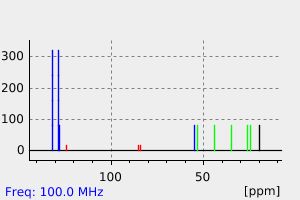2-methyl-1-(3-phenylprop-2-ynyl)piperidine | 78507-72-9
中文名称
——
中文别名
——
英文名称
2-methyl-1-(3-phenylprop-2-ynyl)piperidine
英文别名
——
CAS
78507-72-9
化学式
C15H19N
mdl
——
分子量
213.323
InChiKey
CSLQSYDJCCONOK-UHFFFAOYSA-N
BEILSTEIN
——
EINECS
——
-
物化性质
-
计算性质
-
ADMET
-
安全信息
-
SDS
-
制备方法与用途
-
上下游信息
-
文献信息
-
表征谱图
-
同类化合物
-
相关功能分类
-
相关结构分类
计算性质
-
辛醇/水分配系数(LogP):3.4
-
重原子数:16
-
可旋转键数:2
-
环数:2.0
-
sp3杂化的碳原子比例:0.47
-
拓扑面积:3.2
-
氢给体数:0
-
氢受体数:1
反应信息
-
作为产物:参考文献:名称:二氧化硅接枝 DBU 负载的 NiCl2:用于 A3 偶联的可持续多相催化剂摘要:二氧化硅接枝的 DBU 负载的 NiCl 2络合物,1-(3-((3-(二氧化硅-三氧甲硅烷基)丙基)氨基)丙基)azepan-2-one 氯化镍 (SiO 2 @DBU-NiCl 2 ),已被设计并通过多步法合成,并通过 FT-IR、XRD、EDS、FE-SEM、TGA 和 XPS 进行表征。已经探索了SiO 2 @DBU-NiCl 2的催化活性,用于末端炔烃、醛和仲胺的 A 3偶联,从而获得优异的收率(高达 97%)。本协议的特点是高 TON (625–1212) 和 TOF (52–404)、低催化剂负载量 (0.08 mol %)、无溶剂条件、易于回收和催化剂的可重复使用性(最多 5 次)。DOI:10.1007/s11164-023-04980-1
文献信息
-
Novel 3-phenylprop-2-ynylamines as inhibitors of mammalian squalene epoxidaseElectronic supplementary information (ESI) available: Proton NMR spectra for the intermediate piperidines 56–60 and acetylenes 63-81 and 85,86. See http://www.rsc.org/suppdata/ob/b2/b209165h/作者:David L. Musso、Morris J. Clarke、James L. Kelley、G. Evan Boswell、Grace ChenDOI:10.1039/b209165h日期:2003.1.30The synthesis of a novel series of 3-phenylprop-2-ynylamines as selective mammalian squalene epoxidase inhibitors is described. Structure–activity relationship studies led to the discovery of compound 19, 1-[3-(3,5-dichlorophenyl)prop-2-ynyl]-3-methylpiperidine hydrochloride with an IC50 of 2.8 ± 0.6 µM against rat liver squalene epoxidase. Against 23 strains of fungal squalene epoxidase compound 19 was found to be inactive.
-
Synthesis and characterization of magnetic glycocyamine-modified chitosan as a biosupport for the copper immobilization and its catalytic activity investigation作者:F. Rafiee、F. Rezaie KarderDOI:10.1016/j.reactfunctpolym.2019.104434日期:2020.1coordination. The magnetization of modified chitosan was done using of Fe3O4 nanoparticles. In the presence of coordinated groups of glycocyamine containing amidino and carboxylate, copper ions were immobilized on this magnetic biopolymer. This new nanocomposite (Fe3O4@CSC@AG@Cu) was characterized by FT-IR, FE-SEM, EDX, XRD, VSM, DRS and ICP analysis. After which, its catalytic activity was examined in the three
-
Catalytic Methylene Insertion between Amines and Terminal Alkynes via C–N Bond Cleavage of <i>N</i>,<i>N</i>-Dimethylacetamide: A Unique Route to Propargylic Amines作者:Ajijur Rahaman、Rupali Dasharath Shinde、Sukalyan BhadraDOI:10.1021/acs.joc.2c02584日期:2023.2.3A copper-based system allows for the methylene insertion between an amine and a milder nucleophile, including a terminal alkyne counterpart, via C–N bond cleavage of N,N-dimethylacetamide. The method gives an expedient access to propargylic amines in good to excellent yields. A wide-ranging substrate scope and late-stage functionalization of complex molecules make the protocol practically valuable
-
Khuthier, Abdul-Hussain; Sheat, Mohammed Ali, Journal fur praktische Chemie (Leipzig 1954), 1989, vol. 331, # 2, p. 187 - 194作者:Khuthier, Abdul-Hussain、Sheat, Mohammed AliDOI:——日期:——
-
KHUTHIER, ABDUL-HUSSAIN;SHEAT, MOHAMMED ALI, J. PRAKT. CHEM., 331,(1989) N, C. 187-194作者:KHUTHIER, ABDUL-HUSSAIN、SHEAT, MOHAMMED ALIDOI:——日期:——
表征谱图
-
氢谱1HNMR
-
质谱MS
-
碳谱13CNMR
-
红外IR
-
拉曼Raman
-
峰位数据
-
峰位匹配
-
表征信息
同类化合物
(R)-3-甲基哌啶盐酸盐;
(R)-2-苄基哌啶-1-羧酸叔丁酯
((3S,4R)-3-氨基-4-羟基哌啶-1-基)(2-(1-(环丙基甲基)-1H-吲哚-2-基)-7-甲氧基-1-甲基-1H-苯并[d]咪唑-5-基)甲酮盐酸盐
高氯酸哌啶
高托品酮肟
马来酸帕罗西汀
颜料红48:4
顺式3-氟哌啶-4-醇盐酸盐
顺式2,6-二甲基哌啶-4-酮
顺式1-苄基-4-甲基-3-甲氨基-哌啶
顺式-叔丁基4-羟基-3-甲基哌啶-1-羧酸酯
顺式-6-甲基-哌啶-1,3-二甲酸1-叔丁酯
顺式-5-(三氟甲基)哌啶-3-羧酸甲酯盐酸盐
顺式-4-叔丁基-2-甲基哌啶
顺式-4-Boc-氨基哌啶-3-甲酸甲酯
顺式-4-(氮杂环丁烷-1-基)-3-氟哌
顺式-3-顺式-4-氨基哌啶
顺式-3-甲氧基-4-氨基哌啶
顺式-3-BOC-3,7-二氮杂双环[4.2.0]辛烷
顺式-3-(1-吡咯烷基)环丁腈
顺式-3,5-哌啶二羧酸
顺式-3,4-二溴-3-甲基吡咯烷盐酸盐
顺式-2,6-二甲基-4-氧代哌啶-1-羧酸叔丁基酯
顺式-1-叔丁氧羰基-4-甲基氨基-3-羟基哌啶
顺式-1-boc-3,4-二氨基哌啶
顺式-1-(4-叔丁基环己基)-4-苯基-4-哌啶腈
顺式-1,3-二甲基-4-乙炔基-6-苯基-3,4-哌啶二醇
顺-4-(4-氟苯基)-1-(4-异丙基环己基)-4-哌啶羧酸
顺-4-(2-氟苯基)-1-(4-异丙基环己基)-4-哌啶羧酸
顺-3-氨基-4-氟哌啶-1-羧酸叔丁酯
顺-1-苄基-4-甲基哌啶-3-氨基酸甲酯盐酸盐
非莫西汀
雷芬那辛
雷拉地尔
阿维巴坦中间体4
阿格列汀杂质
阿尼利定盐酸盐 CII
阿尼利定
阿塔匹酮
阿哌沙班杂质BMS-591455
阿哌沙班杂质87
阿哌沙班杂质52
阿哌沙班杂质51
阿哌沙班杂质5
阿哌沙班杂质
阿哌沙班杂质
阿哌沙班-d3
阿哌沙班
阻聚剂701
间氨基谷氨酰胺







